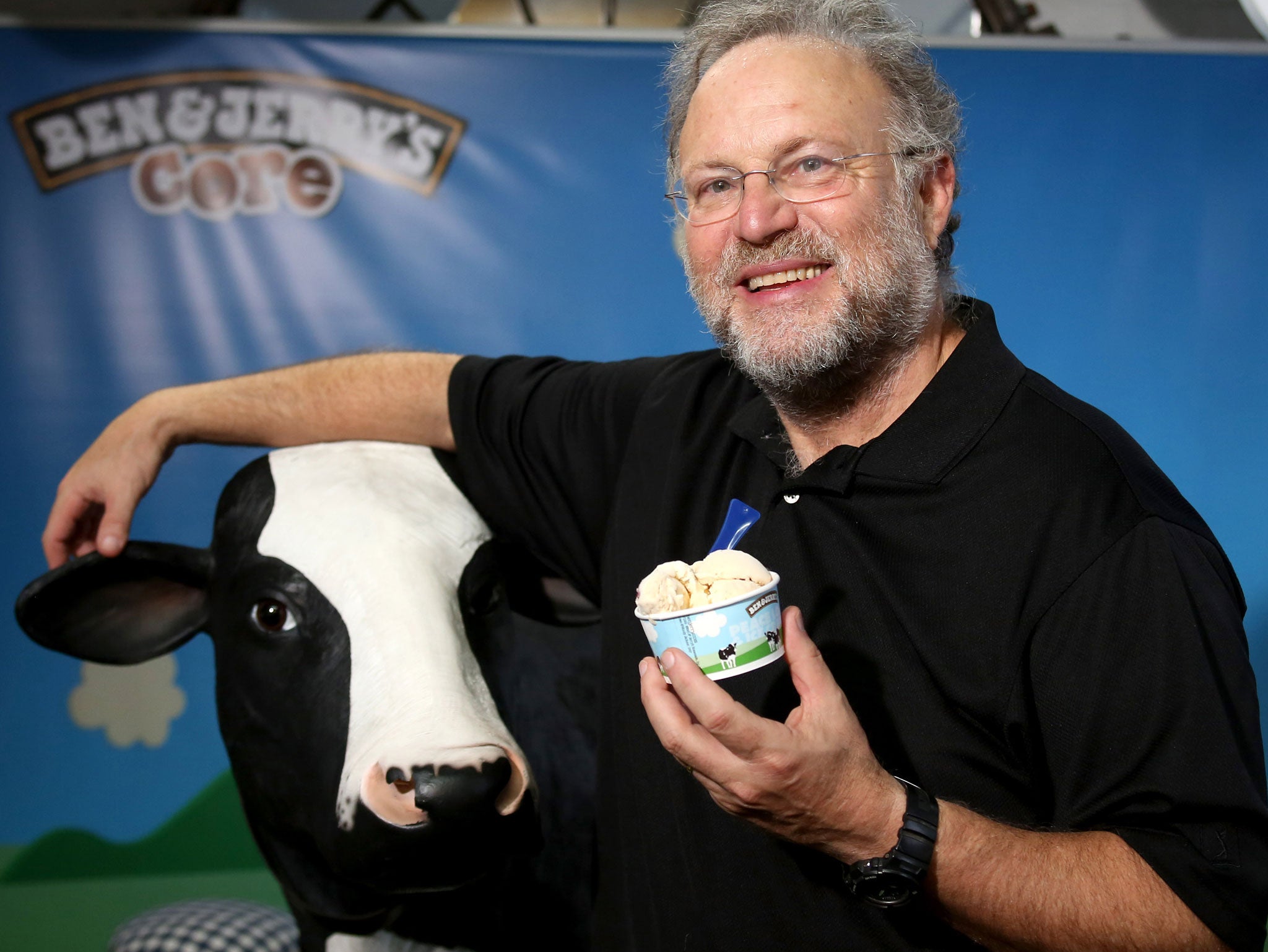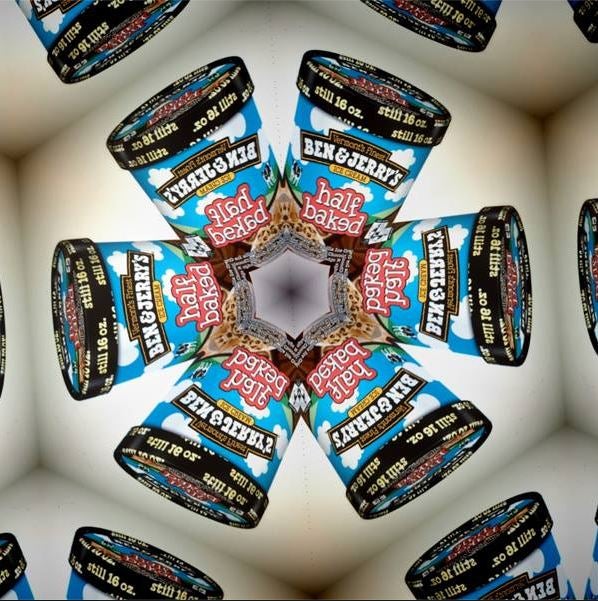Jerry Greenfield of Ben and Jerry's: So what’s so funny about peace, love and ice-cream?
Jerry Greenfield, co-founder of Ben & Jerry's, hasn’t been chilling out since selling to Unilever

“Oh yes, I’m definitely an ageing hippy,” says Jerry Greenfield, with a big giggle.
“Many people think the hippies were irresponsible but we really believed in all that stuff about peace and love and caring for each other; we still do. And we still try to make a difference.”
Jerry is the second scoop of Ben & Jerry’s Homemade, the ice-cream company from which he and Ben Cohen made their fortunes when they sold out to Unilever for $325m nearly 15 years ago; Greenfield made $9.5m while Cohen took away a cool $41m.
They are both still paid to represent the brand, although neither has formal responsibilities or job titles. “Or authority,” says Greenfield. Or privileges: their favourite flavours, Coconut Almond Fudge chip and Mocca Walnut, have been discontinued.

He’s joking of course – the two co-founders are as important and outspoken as ever. “I’ll give you an example. Our stand on the mandatory labelling of genetically engineered products is one issue, which wasn’t included in the agreement with Unilever, but one that they now support. We are now actively campaigning wherever we can on an international level and take a position on full labelling.
“Ben & Jerry’s continues to have an anti-corporatist and anti-authoritarian outlook on all the big issues we care about, such as climate change and social values, and remains outspoken when it’s important.”
The 64-year-old Greenfield is in London to judge one of the company’s latest social enterprise initiatives, known as Join Our Core, a scheme set up four years ago to help young entrepreneurs. “When I look back, there’s no doubt that Ben and I had lots of skills – we were creative and always had ideas. But management strength was not one of them,” he adds.
“We could have done with more help. It’s even more daunting today to build a business. Being an entrepreneur is not easy and the really hard bit is learning how to scale up. The winners will now come over to the mothership in Vermont [where Ben & Jerry’s is based] and have one-to-one mentoring with us and our executives.”
There were more than 450 entries from five countries in Europe for the competition, including over 100 from the UK. They’ve selected two social enterprises that will now be crowdfunded on a rewards- based platform to build up their fan base: GravityLight, an innovative lighting system that uses gravity to provide light for people in the developing world, removing the need for harmful and expensive kerosene; and We Walk the Line, a coffee company that allows socially excluded people to rebuild their lives, by setting up as a micro entrepreneur barista.
Greenfield knows better than most just how difficult it is to fight – and change – the status quo. Up until 1994, Ben & Jerry’s was one of a handful of US companies to take a stand on soaring executive pay by limiting salaries for its chief executive to five times the company’s lowest-paid worker. If the chief wanted to pay himself more, he had to pay the lowest paid more.
“ Our intention was to keep pay of the lowest-paid up as much as control pay for the top management. We were naïve because when we needed to find a new CEO from outside to replace Ben, we thought people would jump at the opportunity to work with us for less than the market rate.

“We were wrong – they didn’t; sadly, we had to drop the policy. Pay levels are worse today and some packages are obscene. Hopefully, shareholders do seem to be more aware that this is an issue than they did. ”
The first years after the Unilever takeover where not easy for them, either, even though those early values were enshrined in a highly unusual sale agreement. This gave them the right to an independent board, with nine of the 11 directors independent of Unilever and the right to veto changes on a whole gamut of issues from ingredients to marketing. Unilever even agreed to pay the legal fees of the Ben & Jerry’s board, allowing it to pursue suits against the global giant if it didn’t live up to the social mission promises.
Yet for many years, the board didn’t stand up for those rights and by 2008 the directors had split into hostile camps, which triggered big changes: Unilever and Ben & Jerry’s both went through management upheavals and the board’s directors started reasserting themselves.
The result? Ben & Jerry’s got its mojo back: annual sales of its ice-cream and frozen yoghurt products across 36 countries have soared to $1bn and next year it will be launching the first mainstream non-dairy ice-cream.
Those early tensions have receded, says Greenfield, and he has enormous respect for Unilever’s current chief, Paul Polman, and the boss of Ben & Jerry’s, the Norwegian Jostein Solheim, who both talk a similar language about the importance of social mission and brand integrity.
While Greenfield concentrates on the philanthropic and social flavour of Ben & Jerry’s, Cohen has taken a more political twist. His latest campaign is Stamp Stampede – a not-for-profit grass-roots movement that he founded to take the big money out of politics. Presidential candidates spent more than $6bn on the last American election, with most of the cash coming from big corporations.

Greenfield, also a supporter, says: “Millions of Americans are fed up with a system that no longer represents them because of the big money that politicians are being paid as an investment by corporations – or the unions. Ben is trying to change that.”
His campaign sells stamps that can be legally stamped on the US paper currency with different messages such as “Money is not free” and “The system isn’t broken, it’s fixed”.
Greenfield says his co-founder is now pushing through an amendment to the US Supreme Court’s ruling in the Citizens United case in 2010, which allowed unlimited political expenditures by corporations and unions.
To date, the Stamp Stampede campaign to overturn this ruling to limit the funding of the big corporates has been supported by 16 states and 150 members of Congress. Word is getting around and Cohen’s guerilla marketing seems to be working: there are now more than 30,000 stamps on US paper bills.
Greenfield adds: “Every time you stamp a dollar bill and put it in circulation, 875 people see it. So that means one person stamping three bills a day reaches one million people. And if 100 people stamped 10 dollars a day for a year, the message would reach more than 300 million people.”
It’s ironic, though, that the Phish Food ice-cream makers can afford to keep teasing the status quo precisely because they made their fortunes selling out to a global giant.
Perhaps it’s time for a new flavour: Stampede with Chunks of Love and Peace #getmoneyoutofpolitics ?
Living the life: Jerry Greenfield
Favourite book: ‘Catch 22’. “Right now I’m really into modern American literature.”
Favourite ice-cream: Cone Sweet Cone.
Favourite film: ‘Maltese Falcon’.
Favourite car: “I’d like to say something really cool, like a Corvette from the ’50s.”
Favourite holiday: “Have you heard of Festivus?”
Favourite music: “Rock’n’roll from my era.”
Typical day
“It’s more typical than people think. It’s probably pretty boring, too. I do a bunch of emails, phone calls and meetings – but I do get to meet some interesting people and work on some meaningful projects, before I go home to my lovely family. I do a fair amount of travel as well. Overall, I do feel like I’m the luckiest guy in the world.”
Timeline: How the cream rose to the top
1978: Ben and Jerry do a $5 correspondence course in ice-cream making and with $12,000 ($4,000 borrowed) open their first scoop shop in a renovated gas station in Burlington, Vermont.
1979: Celebrate one-year anniversary with the first Free Cone Day: free scoops given out to everyone and all day long. The tradition continues today.
1984: They set a precedent by discovering a little-known clause that allows them to establish a Vermont-only public stock offering to raise money for a new manufacturing plant.
1985: The Ben & Jerry’s Foundation is established, with a gift from Ben and Jerry and 7.5 per cent of the company’s annual pre-tax profits, to fund community-oriented projects.
1987: Ben & Jerry’s introduces Cherry Garcia ice-cream after the Grateful Dead guitarist Jerry Garcia.
1991: Eight million ice-cream products carry a “Support Farm Aid” message to help keep family farmers on their land.
1997: Phish Food ice-cream is launched after the Vermont-based band of the same name.
1999: Launch of the Flying Friesian in the UK – a “raucous tour bus” used for fundraising for Childline.
2004: Ben & Jerry’s teams up with Rock the Vote to boost voter turnout in the US by using customers on Free Cone Day to register more than 11,000 voters – the biggest one-day grass-roots registration in Rock the Vote’s history.
2005: Ben & Jerry’s makes a 900lb Baked Alaska out of Fossil Fuel ice-cream and serves it up on Capitol Lawn to protest against drilling in the Arctic.
Join our commenting forum
Join thought-provoking conversations, follow other Independent readers and see their replies
Comments